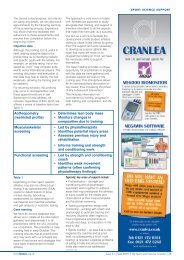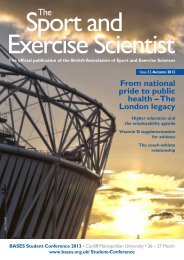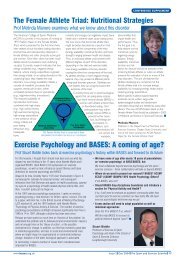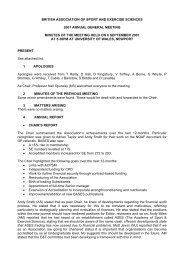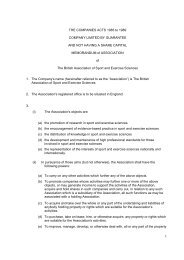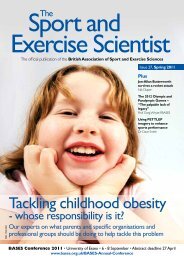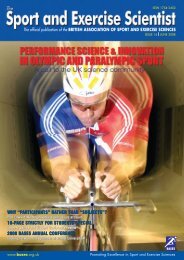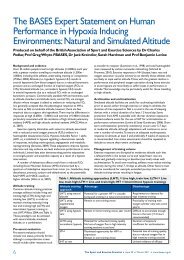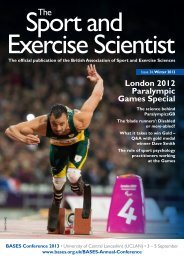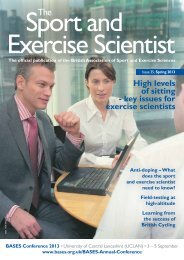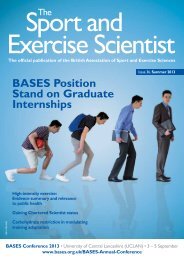Issue 31 Spring 2012 - Bases
Issue 31 Spring 2012 - Bases
Issue 31 Spring 2012 - Bases
Create successful ePaper yourself
Turn your PDF publications into a flip-book with our unique Google optimized e-Paper software.
Left: Eero Mantyranta, multiple Olympic medal winner, had a rare<br />
mutation in his EPOR gene<br />
Dr Alun Williams is Convenor of the<br />
BASES Molecular Exercise Physiology<br />
Interest Group and Director of the<br />
MMU Cheshire Sports Genomics<br />
Laboratory, Manchester Metropolitan<br />
University.<br />
Prof Andy Miah is Director of the<br />
Creative Futures Research Centre,<br />
University of the West of Scotland<br />
and Global Director of the Centre<br />
for Policy & Emerging Technologies,<br />
Washington.<br />
a genetic test performed on an adult.<br />
Consent cannot be obtained from<br />
embryos or very young children.<br />
Many forms of sport and exercise<br />
are effective at improving health, yet<br />
some activities increase the risk of<br />
injury, disease or sudden death, and<br />
there is a genetic component to those<br />
risks. Thus, it is foreseeable that genetic<br />
tests will be developed to stratify<br />
this risk. For example, genetic tests<br />
could be used to make choices about<br />
an athletic career by judging injury<br />
risk, to determine insurance costs or<br />
coverage for sports participation, to<br />
help a sports club decide whether<br />
or not to employ an athlete, or to<br />
assist the individualisation of care for<br />
an at-risk or injured athlete. Genetic<br />
testing may play an important role in<br />
pre-participation screening and reduce<br />
the incidence of sudden death in sport.<br />
Simultaneously, problems might arise<br />
because of difficulties keeping genetic<br />
test results confidential, especially those<br />
of high-profile athletes. A conflict of<br />
interest could occur between clubs<br />
and athletes and some healthy athletes<br />
might erroneously be prevented from<br />
competing because genetic tests of<br />
future poor health or injury are unlikely<br />
to achieve 100% predictive accuracy.<br />
Conclusions and recommendations<br />
The future of sport and exercise science<br />
will become increasingly focused on<br />
genetic research and testing as the<br />
relevant molecular technologies become<br />
faster, cheaper and more widely available<br />
(Lander, 2011). Sport and exercise<br />
scientists need to ensure that they<br />
keep abreast with genomic science to<br />
capitalise on recent and anticipated<br />
findings in an ethically acceptable<br />
manner. It is recommended that:<br />
• Sport and exercise scientists should<br />
maintain their awareness of potential<br />
unwanted consequences of genetic<br />
information and of the potential<br />
misuse of genetic data to justify<br />
discriminatory views or practices.<br />
Sport and exercise scientists should<br />
engage knowledgeably in public<br />
debates to minimise those risks.<br />
• Genetic testing in the sport and<br />
exercise context (with the possible<br />
exception of pre-participation risk<br />
screening) should only be conducted<br />
on mature individuals who fully<br />
understand the relevant issues and<br />
a system of counselling should be<br />
introduced.<br />
• Pre-participation risk screening<br />
should not be obligatory and the<br />
confidentiality of such testing has to<br />
be ensured.<br />
• Sport and exercise scientists should<br />
be aware of the risk that a prominent<br />
“individualised medicine” public<br />
narrative could undermine the<br />
more general advice given to large<br />
population groups regarding the value<br />
of exercise and other lifestyle factors<br />
in disease prevention and treatment.<br />
• Genetic testing should be used in<br />
the fight against doping in sport<br />
where appropriate, to link biological<br />
samples to athletes, test claims that<br />
a genetic mutation was responsible<br />
for a positive doping test or unusual<br />
biochemical data, and test for gene<br />
doping.<br />
PDF Download Download a PDF of this article<br />
www.bases.org.uk/BASES-Expert-Statements<br />
Copyright © BASES, <strong>2012</strong><br />
Permission is given for reproduction in substantial<br />
part. We ask that the following note be included:<br />
“First published in The Sport and Exercise<br />
Scientist, <strong>Issue</strong> <strong>31</strong>, <strong>Spring</strong> <strong>2012</strong>. Published by the<br />
British Association of Sport and Exercise Sciences<br />
– www.bases.org.uk”<br />
Prof Roger Harris (retired)<br />
was formerly Chair of Exercise<br />
Biochemistry at the University of<br />
Chichester.<br />
Prof Hugh Montgomery is<br />
medically qualified and is Director of<br />
the UCL Institute for Human Health<br />
and Performance.<br />
Dr Henning Wackerhage is Vice-<br />
Convener of the BASES Molecular<br />
Exercise Physiology Interest<br />
Group and Senior Lecturer in<br />
Molecular Exercise Physiology at the<br />
University of Aberdeen.<br />
References<br />
Ahmetov, I.I. et al. (2009). The combined impact of<br />
metabolic gene polymorphisms on elite endurance athlete<br />
status and related phenotypes. Human Genetics, 26, 751-761.<br />
Bouchard, C., Sarzynski, M.A., Rice, T.K., Kraus, W.E.,<br />
Church, T.S., Sung, Y.J., Rao, D.C. & Rankinen, T. (2011).<br />
Genomic predictors of maximal oxygen uptake response to<br />
standardized exercise training programs. Journal of Applied<br />
Physiology, 110, 1160-1170.<br />
Bouchard, C., An, P., Rice, T., Skinner, J.S., Wilmore,<br />
J.H., Gagnon, J., Perusse, L., Leon, A.S. & Rao, D.C.<br />
(1999). Familial aggregation of VO 2max response to exercise<br />
training: results from the HERITAGE Family Study. Journal of<br />
Applied Physiology, 87, 1003-1008.<br />
Bouchard, C. et al. (1998). Familial resemblance for VO 2max<br />
in the sedentary state: the HERITAGE family study. Medicine &<br />
Science in Sports & Exercise, 30, 252-258.<br />
Hagberg, J.M., Rankinen, T., Loos, R.J., Perusse, L.,<br />
Roth, S.M., Wolfarth, B. & Bouchard, C. (2011).<br />
Advances in exercise, fitness, and performance genomics in<br />
2010. Medicine & Science in Sports & Exercise, 43, 743-752.<br />
Lander, E.S. (2011). Initial impact of the sequencing of the<br />
human genome. Nature, 470, 187-197.<br />
Williams, A.G. & Folland, J.P. (2008). Similarity of<br />
polygenic profiles limits the potential for elite human physical<br />
performance. Journal of Physiology, 586, 113-121.<br />
Williams, A.G., Wackerhage, H., Miah, A., Harris, R.C.<br />
& Montgomery, H.E. (2007). Genetic research and testing<br />
in sport and exercise science: BASES Position Stand. British<br />
Association of Sport and Exercise Sciences. Available: www.<br />
bases.org.uk/BASES-Expert-Statements<br />
The Sport and Exercise Scientist n <strong>Issue</strong> <strong>31</strong> n <strong>Spring</strong> <strong>2012</strong> n www.bases.org.uk<br />
15



